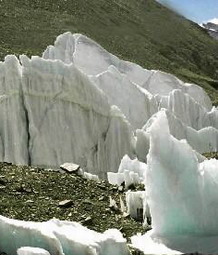| Home / Environment / News | Tools: Save | Print | E-mail | Most Read |
| Global Warming Threatens 'World Barometer' |
| Adjust font size: |
The Qinghai-Tibet Plateau, which accounts for nearly one quarter of It’s the highest and youngest plateau in the world and been dubbed "the third pole." It’s also home to the source of many big rivers in "As the 'thermometer' of the global environment any slight environmental change on the plateau is a reflection for the globe," said Zhang Hongtao, deputy director of the China Geological Survey. The survey, which used remote sensor technology, was designed to provide an overview of the plateau's geological condition and assist in its future economic development, Zhang said. "The direct harm is the threat of the loss of the country's freshwater resources," said Fang Hongbin, senior engineer at the RSD. "Furthermore, we won't have any shield to protect ourselves from the sand blowing from the plateau if the desertification trend is not checked." Fang suggested speeding up a project called "Return the Land to Green" in the western part of the country as well as strictly controlling the raising of livestock and mining activities on the plateau. Even if the world's global climate didn’t continue to get warmer researchers estimate the plateau's glacial areas will shrink to 72 percent of the current level by 2050 and 50 percent by 2090, Fang said. "The melting of the glaciers and snow has provided huge water resources for the plateau and its surrounding areas and led to a temporary increase of wetlands and lakes in some regions," said Fang. "But with the constant decrease of glaciers and the rising of the snowline the total water reserve of the plateau keeps declining." The glaciers on the plateau show an obvious trend of shrinking especially around the edges. The trend has gained momentum in recent years, the survey showed. The snowline on the edge of the plateau has also been drastically reduced with an average distance of 100 to 150 meters lost with the most significant being 350 meters. Although the desert region of the area has changed only slightly those parts of medium and heavy desertification saw a huge increase. This will result in further desertification in the future. ( |
| Tools: Save | Print | E-mail | Most Read |
 |
| Related Stories |
|
||||
